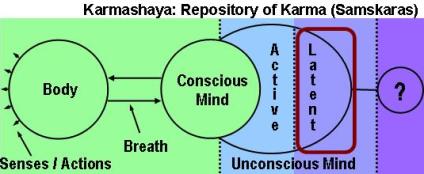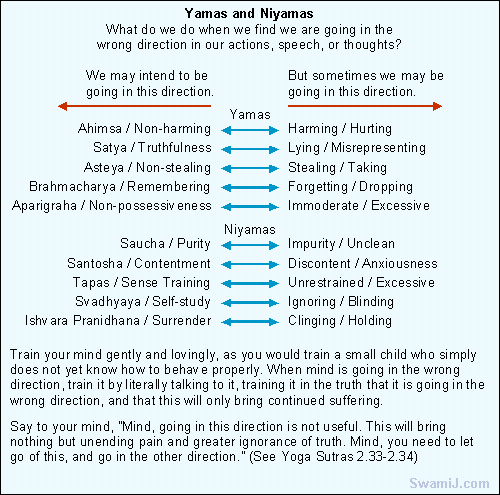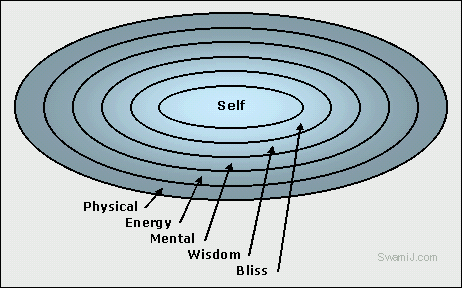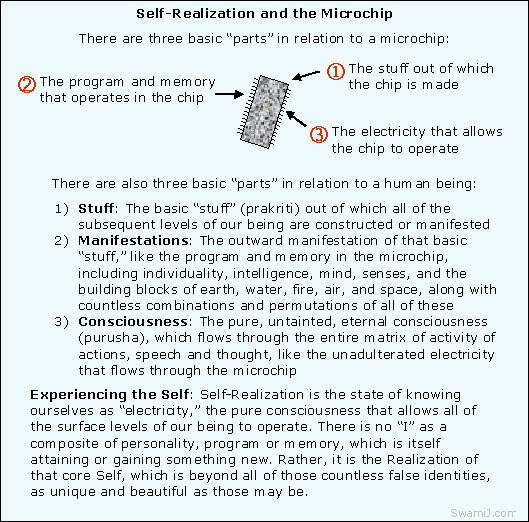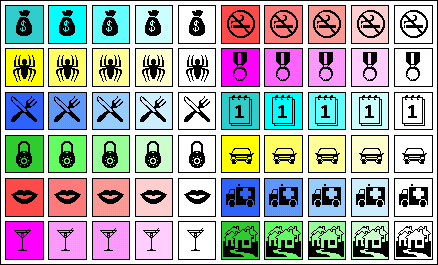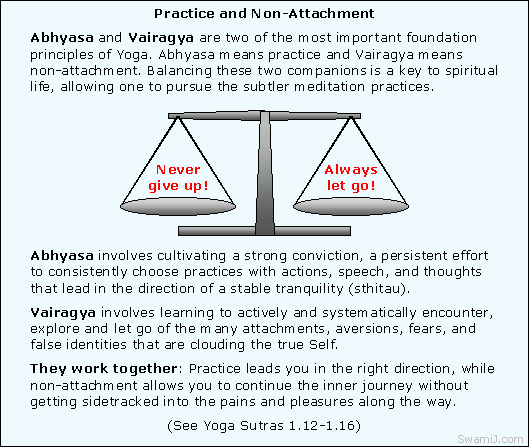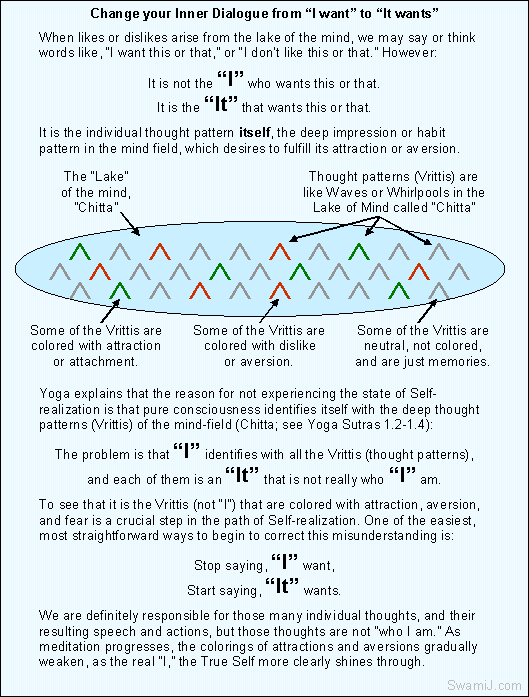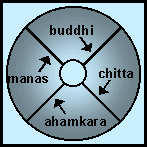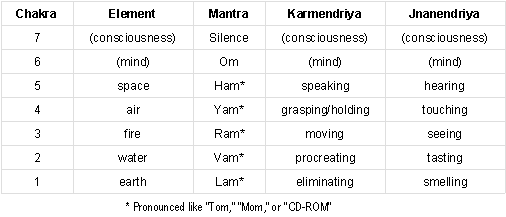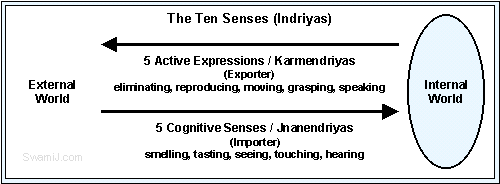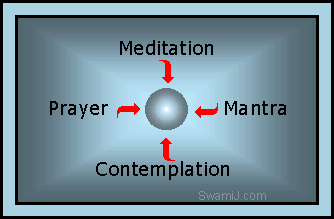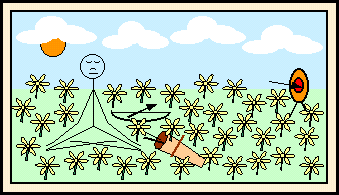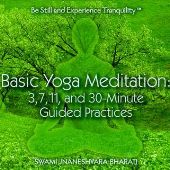Karma
Reducing
Karma and the Sources of
Negative
Actions, Speech, and Thoughts
by Swami Jnaneshvara Bharati

This article is available in print:

|
|
||||
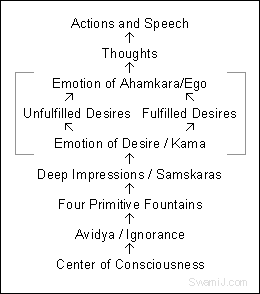 |
Outline of the process of Karma: The process of Karma is outlined in the chart at the left. As you scroll down through this article, you will find detailed descriptions of each of the stages on the chart. The particular section being described is highlighted in blue in the accompanying chart. It is also useful to read these pages about karma: |
|||
|
Law of Karma: The law of Karma is a universal process, whereby causes lead to effects. This is something that all of us are already familiar with, whether or not we use the word Karma to describe it. Newton's third law of motion, that every action leads to a reaction, is an application of the law of Karma. Whether we are talking about physics or daily life in the world, it is extremely useful to understand the law and process of Karma so that we may regulate or direct the process. We can soften the impact of the playing out of our past Karmas, and can choose our own future Karma if we are willing to put in the effort to learn how to do it. Remember the Bliss beyond Karma: When journeying through the process of Karma, it can start to feel a bit heavy with all the explanations and inner explorations. The best companion on this journey through Karma is to remember that we are trying to experience that Bliss, Joy, or Absolute Truth, which is beyond, behind, or underneath all of the Karma. By remembering that the goal is Joy, Bliss, or Absolute, we (and the mind) will have a focal point and a context for all of the efforts put into sadhana (spiritual practices). Above all else, seek that Joy or Bliss.
|
||||
|
VIDEO: Sam Skara, Terminator of Karma
|
||||
|
Two Essential Terms |
||||
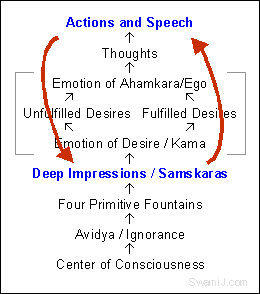 |
Two
essential terms:
To understand the
meaning of Karma, and to reduce its control through Yoga, one needs to
understand another term, and that is Samskara. Karma literally means
actions, and those actions
come from the deep impressions of habit that are called Samskaras.
These two act together: Our actions and speech bring us experiences or consequences in the world. Those, in turn, lead to further creation of deep impressions (Samskaras) in the basement of the mind. Later, those latent impressions come to life and create still further experiences. We must deal with both: If we
want the higher insights and freedoms, we need to deal with both our
actions and these habits. |
|||
|
Samskara is the most important principle: The most important principle to understand about Karma is the principle of the Samskara, those deep impressions. It is those deep impressions or seed habit patterns, which are at the root of ALL of our Karmas, whether we think of that Karma as good or bad. There are two general things we need to do in relation to those Samskaras:
Karma Yoga: To purify or attenuate the Samskaras while one is doing actions in the world is the Yoga known as Karma Yoga. This involves being aware or mindful of our actions and speech, and seeing their sources in emotions and the subtler processes of the mind. Karma Yoga also involves doing our actions in ways, which are of benefit to others (service or seva), freeing ourselves from the cycles of feeding egotism. Subtler freedom through Meditation: The subtler, finer colorings of Samskaras are systematically encountered, weakened, reduced, eliminated and transcended through the process of meditation. This is outlined in greater detail in the Yoga Sutras, including the first 25 Sutras of Chapter 2. Cycling process of the inner instruments: To experience the Eternal Self beyond the many forms, one needs to experientially understand the cycling process of the inner instruments that drives Karma (actions). This cycling process between actions and the deep impressions also is affected by the inner thinking process, the emotions, primitive urges, and the ignorance called Avidya. All of these are infused with or operated by the pure consciousness, which is at the core of our being. (These are described in the article.) Attenuating the deep impressions: By observing this process in one's own inner laboratory of Yoga Meditation, the effects of deep impressions (Samskaras) can be reduced, and thus, Karma regulated. This process of attenuating Samskaras and Karma increasingly allows attention to shift to the viewing point of Witness of it all. The cycle of actions (Karma):
|
||||
|
Three Freedoms |
||||
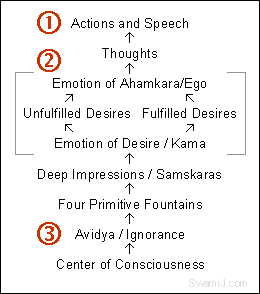 |
Three freedoms come: There are three general stages of freedom that come from this process of dealing with Karma:
|
|||
|
Emerging freedoms: These three freedoms emerge in stages. The direct experience of the Center of Consciousness, the Self, leads towards all three of these freedoms. Observe and Regulate your actions and speech: One of the first things to do in sadhana (spiritual practices) is to regulate actions and speech, promoting the positive and useful, while setting aside the negative and not useful. This is the first part of breaking the cycles of actions and reactions, or Karma. In Yoga, this includes practicing the Yamas, which are not harming, truthfulness, not stealing, remembering higher truth, and not being possessive (Yoga Sutras 2.30-2.34). Initially these practices might be done on the more surface level, like behavioral psychology, but later are done on a subtler level through meditation (Yoga Sutras 2.10-2.11). Then the roots of those negative or not useful actions and speech are dealt with through meditation at the level of Samskaras (See the Samskaras level on the chart). Witness your Emotions and Thoughts: Observe your emotional reactions during the day and you will easily notice that most, if not all of them are one of two types. The emotions are either in getting what you want (or successfully avoiding what you don't want), or not getting what you want (or failing to avoid what you don't want). These emotional reactions will cluster around happiness or pride when we get our way, and frustration or jealousy when we do not get our way. These reactions might be intense or very mild. One of the most straightforward and useful practices in observing these emotional reactions is to ask ourselves, "What desire is being fulfilled here?" or "What desire is not being fulfilled here?" In either case, it is very useful to witness these emotional reactions, as they give us clues about the underlying Deep Impressions (Samskaras), and can help us see the way the Four Primitive Urges (see chart) set the stage for these. Then they can be systematically attenuated, eventually revealing the joy and Truth underneath. Remember and observe the basic forms of Ignorance: It is extremely useful to notice from time to time the many ways in which we forget the subtler realities in our busy daily lives. Avidya means ignorance, to not see clearly. Avidya literally means without-knowledge, as the a- means without, and vidya means knowledge (See Yoga Sutra 2.5). We may observe, for example, some frustration when something we own breaks, is lost, or is stolen. The root of the frustration comes because of forgetting the temporary nature of things. When somebody says something negative about us, we might feel hurt or become defensive because of the root forgetting of who I am, thinking that I am my personality. Remembering the reality of things can help lead to freedom, though we will also need to deal with these in subtler meditation. (See the Avidya/Ignorance level on the chart )
|
||||
|
About the descriptions below... |
||||
|
Descriptions from inner to outer: The descriptions below explain the process of Karma by starting at the subtlest level and then progressively moving outward. One after the other, the process emerges through these levels until there is finally a playing out of actions (Karmas) in the external world. The particular section being described is highlighted in blue in the accompanying chart. |
||||
| |
||||
|
Center of Consciousness |
||||
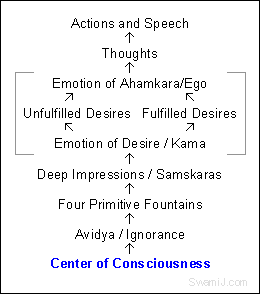
|
Center: Underneath all of the levels and layers of inner process affecting Karma is the Center of Consciousness (or whatever name one chooses to call it). Understanding the process of Karma and its sources does not require one to use or believe in any particular term or concept for this ultimate level that we are here calling Center of Consciousness. The principles and processes of Karma apply to all people, regardless of how we might conceive this core of consciousness. Conditioning: It is the conditioning of this otherwise pure consciousness that relates to Karma and the sources of actions, speech, and thoughts. The Center of Consciousness has been placed on this chart so that we can see the way in which this conditioning process happens. |
|||
|
Be ever mindful of your Center: Cultivate an attitude of constant awareness of the core of your being, or center of consciousness. It doesn't matter whether you use these terms, or refer to that center as Self, Soul, Atman, or some other name. It is very useful to be mindful of that center while doing your actions in the world. Attention may not be there continuously, but can pop into awareness from time to time. This allows you to see the way in which the center is, as the name says, the center from which all of the other deep habits, emotions, thoughts, actions and speech emerge. Remembering often: To recall this center of consciousness is a frequent reminder that who I am is independent of these habits or Samskaras (though we are responsible for them), much as if we were to see ourselves as being electricity, independent of the machines or instruments we might operate. This practice is a real key to internalizing or remembering the whole of this process of Karma, and learning how to deal with it. This is often called Meditation in Action or Mindfulness.
|
||||
| Avidya / Ignorance | ||||
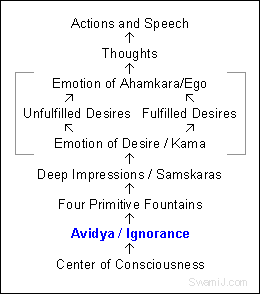 |
Avidya/Ignorance:
Avidya means ignorance, or to not see clearly. Ignorance
does not mean stupid or lacking in intelligence, but refers to the
root ability to ignore.
Wave forgets it is ocean: Imagine an ocean, which is an ocean of consciousness, and that the wave forgets that its essential nature is that of the ocean itself. That forgetting, or ignoring, allows the wave to think that it is an individual, independent of the ocean. We humans do this too; we forget we are part of the whole, and declare, "I am so-and-so." See also Yoga Sutras on Avidya or Ignorance: |
|||
|
Kinds of Avidya: The aspect of Avidya that has to do with our fundamental forgetting that we are part of the whole is an extremely subtle part of our being. However, this process also manifests in more surface ways as well. For example, Avidya (ignorance) sets the stage for us to confuse pain for pleasure, impure thoughts for pure thoughts, temporary for long lasting, and our actions as being our identity. You might want to read through Yoga Sutra 2.5 on types of Avidya. Opens the door to Karma: This primal forgetting or ignorance of Avidya allows for the possibility of the chains of Karma, or cause and effect. Imagine for a moment that you were a totally enlightened sage, and that you never, ever, lost touch with your eternal Self. If you were in that state, you would be free, at all times, even when actions were playing out! However, those who are not free, who do have Karma, are influenced by this foundation of Ignorance or Avidya. In forgetting our True Nature and falsely identifying ourselves with the objects of the world that are stored in the mind, we are subject to the playing out of the seemingly endless cycles of desires and actions, cause and effect. The whole process of Karma begins with, or rests on the foundation of Avidya or Ignorance. Avidya/Ignorance
is like Forgetting... The wave forgets the
truth that it is ocean, thinking itself Avidya is an ability: This Avidya or Ignorance is actually an ability or skill, in addition to being the most subtle obstacle; it is not all bad. While it is true that Avidya masks our True Nature, it also allows us to function in the world. Imagine that you did not have the ability to ignore all of the thoughts going on in your unconscious mind at a given moment. This could be a state of what psychologists call flooding of unconscious material, which might be called psychosis. If we were masters of non-attachment (See Yoga Sutras 1.15-1.16), then we could be completely open, with no Avidya or Ignorance, and we would be unaffected by that flood of thoughts. That would be a state of complete freedom from the bondage of Karma, the bondage of thought, and the bondage of Avidya. However, in the meantime, it is good to see how Avidya sets the stage for the play of Karma, so we can do the practical work in our daily lives as spiritual aspirants.
|
||||
| Four Primitive Fountains | ||||
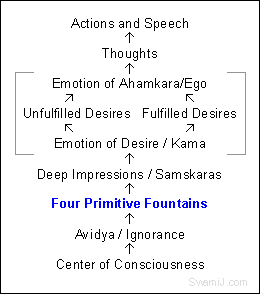 |
Four
Primitive Fountains: All creatures share some common drives, which
form the root of all other drives, wants, wishes, or motives,
which might be more specific in nature. While you might see other
nuances within these, there are four basic urges for food, sleep, sex,
and self-preservation.
Others come from these: These are called fountains because other drives spring from these four, combining and recombining in many complex combinations. |
|||
| See
also the articles: Lifestyle and the Four Basic Urges Four Primitive Fountains Generalized urges: These four primitive urges are very generalized, while the ensuing experiences of life lead to more particularized drives, habits, or conditionings. Thus, for example, all creatures have a drive toward sustenance, which we can broadly call food. However, humans have a narrower range of appropriate food compared to others. For example, the food of an algae growing in a pond might be different than what people eat. As our food drive becomes more particularized, we might develop a predisposition for healthy food or tasty food, for apples or chocolate. Also open the door to Karma: As was mentioned above in relation to Avidya or Ignorance, these very broad Primitive Urges also allow for the next level of conditionings to occur, where we start to get a real feel for the nature of Karma and how we actually deal with it in our spiritual lives and meditation practices.
|
||||
| Deep Impressions / Samskaras | ||||
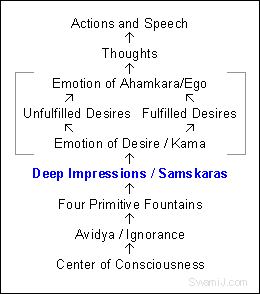 |
Deep impressions drive Karma: There are many layers and levels of Samskaras, the stored impressions resulting from actions and desires, asleep in the unconscious. Latent, but with potential: In their latent form, these Samskaras have no immediate impelling force to action, but only the potential for such action. These are the driving force of our Karma. Sometimes the Samskaras become active, and then they motivate and control the mind and the emotions, which in turn leads to the possibility of actions (Karma). Sleeping desires: Just as a person may sleep, these latent impressions are usually asleep, so to speak. It is only when they become active that they stir into active desires. |
|||
|
These two act together: Our actions and speech bring us experiences or consequences in the world. Those, in turn, lead to further creation of deep impressions (Samskaras) in the basement of the mind. Later, those latent impressions come to life and create still further experiences.
We must deal with both: If we want the higher spiritual freedoms and insights, it is necessary not only to deal with the external actions or behavior, but also with the deep, internal impressions or Samskaras. These must be systematically encountered, weakened, eliminated, and transcended. Karma Yoga: To purify or attenuate the Samskaras while one is doing
actions in the world is the Yoga known as Karma Yoga. This involves
being aware or mindful of our actions and speech, and seeing their
sources in emotions and the subtler processes of the mind. Karma Yoga
also involves doing our actions in ways, which are of benefit to
others, freeing ourselves from the cycles of feeding egotism.
Subtler freedom through Meditation: The subtler, finer colorings of Samskaras are systematically encountered, weakened, reduced, eliminated and transcended through the process of meditation (See Yoga Sutras, including the first 25 Sutras of Chapter 2). Cycling process of the inner instruments: To experience the Eternal Self beyond the many forms, one needs to experientially understand the cycling process of the inner instruments that drives Karma (actions). This cycling process between actions and the deep impressions also is affected by the inner thinking process, the emotions, primitive urges, and the ignorance called Avidya (See Yoga Sutra 2.5 for more info about Ignorance or Avidya). All of these are infused with or operated by the pure consciousness, which is at the core of our being. Attenuating the deep impressions: By observing this process in one's own inner laboratory of Yoga Meditation, the effects of deep impressions (Samskaras) can be reduced, and thus, Karma regulated. This process of attenuating Samskaras and Karma increasingly allows attention to shift to the viewing point of Witness of it all. Samskaras must be examined and purified: To make progress in regulating Karma, the Samskaras need to be examined and purified, which means to gradually attenuate their intensity, until they can finally be completely purified in the inner fire of pure consciousness. This is an important part of the process of Yoga Meditation and Yoga Nidra as tools to deal with Karma. Uncoloring Your
Colored Thoughts
See the beginning of this article: The relationship of Samskaras to the whole of the process of karma, and this relationship is also explained at the beginning of this article. See also these articles:
|
||||
| Emotions | ||||
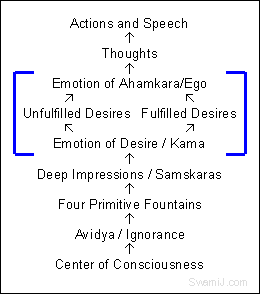 |
Emotions:
These three lines in the chart relate to Emotions, and are further
explained in their individual sections.
Which comes first? It is a very common to ask, "Which comes first, thoughts or emotions?" The answer is, "both!" By understanding the law and process of Karma, this is easy to see.
|
|||
|
Latent
thoughts > Emotions > Active thoughts: Thus, we see that the latent
thought impressions (stored from our countless experiences) lead to an
emotional process, which then lead to an active thought
process, which, in turn, leads to actions and speech. This Active
thought process occurs through an aspect of mind called manas
in Yoga science and sensory-motor mind in psychology. Witness the Emotions often during daily life: It is extremely useful to become a witness to our own emotional processes during our actions in the world. Isn't it true that we often, and easily observe the gestures, body language, and emotional reactions of others? If we can so easily see it in others, we can also see it in ourselves. By clearly seeing our own positive and negative emotions (those are the culprits), we can promote or strengthen the positive, useful emotions like love, compassion, benevolence, and acceptance (See Yoga Sutra 1.33 for meditation on these positive emotions). Witnessing our own body language, speech, actions, and our emotional reactions will give us a mirror reflection of our Deep Impressions or Samskaras. It also allows us to see the predictable ways in which the Four Primitive Fountains (food, sleep, sex, self-preservation) play out. Thus, we not only learn to regulate our emotions in positive ways, but also come to see the roots from which they arise. This self-witnessing in daily life is a major part of Karma Yoga, going along with doing our actions selflessly for others.
|
||||
| Emotion of Desire / Kama | ||||
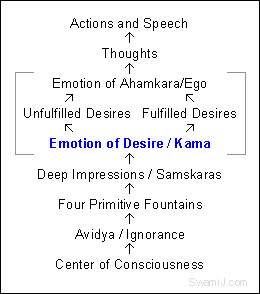 |
Desire as it's own entity: Kama is desire itself (a different word than Karma, which means actions stemming from desire), and is one of the two primary emotions (along with ahamkara). Kama is the mother of all other desires. It gives rise to both the desire to satisfy the senses, and the beneficial desire to help others selflessly. Desire is a single process: Regardless of the particular object being desired, the process of Desire itself is the same. The same wanting, wishing, or longing, etc., is there. Think of examples in your own life and you will see this clearly, that there is a fundamental wave of Desire, which then associates with particular objects. |
|||
|
Kama, not Karma: Note the the word for desire is kama (without the letter "r"), and that the word for actions is karma (with the letter "r"), which are two different words and concepts. Think of your favorite desires: Whether the desire is for your favorite food, the comfort of family life, success on your job, money in the bank, or a new car, the desire itself is the same. With some reflection, it becomes easy to see the way in which the prime desire allies itself with the particular objects. This is not bad, and is not to suggest that one should suddenly attempt to abandon all desires in the world. Rather, it means being aware of how the unconscious process of karma works so that those desires do not make you a slave to their intensity. Kama is the prime desire: Kama is the prime desire, and from this impelling force arise all of the other, specific desires. It is this prime force of kama which motivates a person to do anything and everything. Kama is blind desire that has not yet been related with any particular objects or thoughts. It is the nature of kama that it has no sense of discrimination, judgment or understanding. Kama then associates itself with deep impressions (Samskaras), and that combination then motivates one to do something simply to fulfill that desire—solely because it exists. Desire pulls one outward: All of these desires draw one outward, into the domains of mind and the physical world, so as to seek to fulfill the desires, either in Dreaming or Waking states. The fulfilling of these desires is Karma, stimulated by kama. One desire stands alone: There is one desire that stands alone as different. That is, the desire for Truth, Reality, Self, or God, and this desire alone draws the attention inward, past all of the other desires, conditionings of Samskaras, Karma, and Primitive Fountains. (See the paper on the koshas.) Association of Desire and objects is key: By seeing the way this uniform process of Desire associates with numerous objects, we come to see a universal need to gain some degree of mastery over the process of Desire itself. If we can do that, even to a small degree, we can start to regulate our actions and speech, which alters our consequences in beneficial ways. This changes the Deep Impressions or Samskaras in the basement of the mind.
|
||||
| Unfulfilled Desires / Fulfilled Desires | ||||
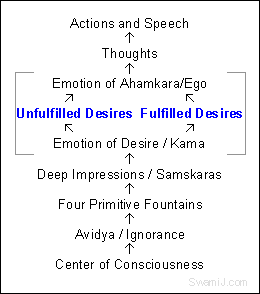 |
Desire combines with Samskaras: In the previous section on the Emotion of Desire itself (Kama), desire is seen to be its own motivating force. It is a coloring, so to speak, which then associates with the latent impressions (Samskaras) in the bed of the lake of the mind. There is one essence of desire and many objects to which it might associate. Thus, there may be countless possibilities of "desired objects," while there remains only one coloring of desire itself. Desire works in 1 of 2 ways: Once there is a particular desire (or aversion, which is also a desire of sorts), there are only two possibilities:
|
|||
See also this article
on Emotions: Four Meditations on Positive Emotions: Yoga suggests meditation on four positive emotions as a means of stabilizing and clearing the mind. These four are meditations on love, compassion, benevolence, and acceptance (See Yoga Sutra 1.33 for meditation on these positive emotions). Meditation on these positive emotions is done both by being mindful of them during the day, and also consciously, intentionally practicing them at your regular meditation time. Meditation on these attitudes brings a tremendous amount of freedom from difficult relationships with the people in our personal lives, and our fellow humans in general. To feel an ever increasing sense of love, compassion, benevolence, and acceptance is a beautiful experience. Preparing for advanced meditations: In relation to the whole of the process of dealing with Karma and enlightenment, these meditations on attitudes or emotions are preliminary, and set the stage for the more advanced meditations to come later. In the later meditations, the aspirant is seeking out the roots, which are beyond, or deeper than the emotions, however beautiful and alluring those might be. The seeker of enlightenment is seeking all of the levels of freedom (described above), so as to eventually experience the highest Bliss and Truth beyond.
|
||||
| Emotion of Ahamkara / Ego | ||||
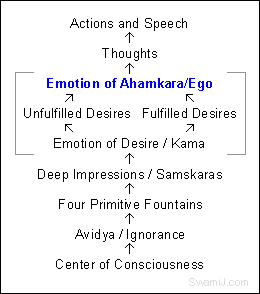 |
Either way, Ego may increase: Whether desires are fulfilled or not fulfilled, Ego can increase. If desires are fulfilled, Ego can increase because of the pride and other emotions associated with attaining ones goals. Ego even further takes on the identities related to those objects of desire. If desires are not fulfilled, Ego can increase because of the frustration and other emotions associated with not attaining ones goals. Ego seeks to defend its stance, and thus increases. Either way, one can end up facing the challenge of an increased sense of Ego. |
|||
|
Ego and desire are two primary emotions: Egoism, or ahamkara, is one of the two primary emotions (along with the prime desire, kama). Notice carefully how this works. Two meanings of "Ego" It is extremely important to understand that the word Ego is used in two different ways. One is the psychological use of the word and the other is according to Yoga. Both are equally valid and the terms can properly be used in both ways. However, it is necessary to know the two concepts so that it is easy to discern which way the word is being used in a given sentence. See the section on Two Egos in the Four Functions of Mind article. Ego gives individuality and separation: Because of ahamkara, we are individuals, but then ahamkara also separates us from the whole. This “I” refers to ourselves as separate from others, and becomes the center of our lives. Four functions of mind: To understand the origin of ahamkara (the "I"), it is very important to understand the Four Functions of Mind. We are like a wheel, which needs both spokes and a hub to rotate. The hub is the still Center of Consciousness and the four spokes are the four functions of mind, one of which is ahamkara. The Four Functions of Mind are:
Emotion is stronger than intelligence: Intelligence has no power before bhava, the power of emotion. But intelligence, if properly handled, can channel emotional power so that we can use it positively. Learning to use bhava properly is essential to successful living and working with Karma. If one can use that emotional power, the highest state of ecstasy can be attained in a second’s time. Spiritual bliss is not an emotion: It is important to note that the emotions of personality that interact with mental process are at a different level of reality or consciousness than the bliss, or ananda that is deeper in our being. This is explained in an article on the Koshas (sheaths), paying particular attention to the descriptions of manamaya kosha and anandamaya kosha.
|
||||
| Thoughts | ||||
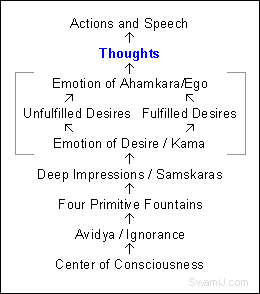 |
Actions come from thoughts: No action (Karma) can ever be performed unless we think of, or want it to happen at some level of mind. Habit patterns define personality: Our personalities have been woven by our habit patterns (Samskaras and Karma), and our habit patterns are the result of our repetitive actions. If we look at ourselves closely, we will realize that our habits really are our personality. In a sense, we become our Karma, while at the same time the true Self resides there, underneath, all along. Emotions control thoughts, which control actions: The real motivation for actions (Karma) is our thoughts. All of our actions are controlled by our thoughts, and all our thoughts are controlled by our emotions. Compared with our emotions, thought has little power.
|
|||
| Actions and Speech | ||||
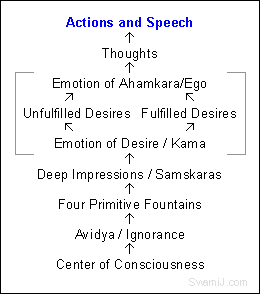 |
Mind functions through ten senses: Actions and speech involve the use of the five active senses (karmendriyas) of eliminating, reproducing, moving, grasping, and speaking, and the five cognitive senses (jnanendriyas) of smelling, tasting, seeing, touching, and hearing. The mind functions through these ten senses (indriyas). (Each of these operates sequentially from the first five chakras.) Conscious
is controlled by unconscious: Whenever an event
occurs that relates to an impression in the deep bed of the mind, then the deep
impression or Samskara becomes active and starts the
process of manifesting the Karma. The conscious mind
is actually controlled by the unconscious, which is why we can have
some difficulty making progress in our growth and spiritual life. |
|||
|
Consequences control our lives: All of our actions bring responses that leave an impression in the unconscious mind. These impressions become our Samskaras and then control our lives. Thus, a cycling process continues, day after day, life after life, and this process is known as Karma.
Training the senses and actions: The training of our senses and actions (indriyas) is a most important part of breaking the cycles of Karma. See the article Training the Ten Senses or Indriyas, which describes the following graphic: Training Speech with mantra or affirmations: It is common knowledge that the self-talk or chatter we do internally has an effect on our mind. Negative inner talk creates negative impressions in the basement of the mind (the level of Samskaras), which, in turn, play out through the levels described in this article, once again leading to actions and speech, and more karma. One of the finest tools for dealing with the chattering, negative self-talk is mantra. By repeating mantra over and over and over, the cycle can be weakened, if not broken (not meaning the suppression or repression of thoughts and emotions that need to be examined). One might use a single syllable seed mantra, a longer mantra, a short prayer, or a simple affirmation. Whichever is used, it becomes a constant companion, repeating itself, over and over, like a song that becomes a mental habit, thousands of times a day. This extremely useful practice can only be appreciated by experimenting with it for some time.
|
||||
| Actions/Speech & Samskaras | ||||
 |
These two act together: Our actions and speech bring us
experiences or consequences in the world. Those, in turn, lead to
further creation of deep impressions (Samskaras) in the basement of the mind.
Later, those latent impressions come to life and create still further
experiences.
The Goal: The goal of meditation and contemplation is to know the pure Center of Consciousness. To to do this we need to regulate our actions and speech and reduce the Deep Impressions or Samskaras. This process eventually allows the light of the True Self to come shining through. Good decisions and practice: Two major keys in this process are to make good decisions about our daily life and spiritual activities and to then follow through on the actual practices. Together, these are like the left and right feet walking the journey of Self-Realization. |
|||
|
|
||||
|
|
||||
------- This site is devoted to
presenting the ancient Self-Realization path of
the Tradition of the Himalayan masters
in simple, understandable and beneficial ways, while not compromising
quality or depth. The goal of our sadhana or practices is the highest
Joy that comes from the Realization in direct experience of the
center of consciousness, the Self, the Atman or Purusha, which is
one and the same with the Absolute Reality.
This Self-Realization comes through Yoga meditation of the Yoga
Sutras, the contemplative insight of Advaita Vedanta, and the
intense devotion of Samaya Sri Vidya Tantra, the three of which
complement one another like fingers on a hand.
We employ the classical approaches of Raja, Jnana, Karma, and Bhakti
Yoga, as well as Hatha, Kriya, Kundalini, Laya, Mantra, Nada, Siddha,
and Tantra Yoga. Meditation, contemplation, mantra and prayer
finally converge into a unified force directed towards the final
stage, piercing the pearl of wisdom called bindu, leading to the
Absolute.
 The word
Karma literally means action. It may appear
that Karma is happening to us, as if some outside force is
causing good things or bad things to come to us.
However, it is really our own inner conditionings and processes
that are leading us to experience outer effects or consequences
in relation to our own actions.
The word
Karma literally means action. It may appear
that Karma is happening to us, as if some outside force is
causing good things or bad things to come to us.
However, it is really our own inner conditionings and processes
that are leading us to experience outer effects or consequences
in relation to our own actions.